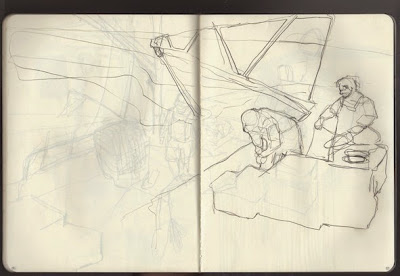.jpg) |
| Sketchbook drawings |
What has also (surprisingly) appeared in my drawings is the figure. A series of journal drawings about the interactions between the deckhands on the cray boat have appeared and are currently continuing to occupy studio time. In 10 years of practice I have never directly referenced the figure in my work, and so this is a very unexpected twist in the journey, but a direction I feel compelled to take. Silent conversations between figures, and between figures and environment.
Recently I read an essay by Rebecca Solnit, The Annihilation of Time and Space. In this piece Solnit discusses the influence of Eadward Muybridge's photographic images capturing animals and man in motion. "It was as though he had grasped time itself, made it stand still, and then made it run again, over and over. Time was at his command as it had never been at anyone's before." She goes on to discuss how motion pictures, the railways and the invention of the telephone continued to dramatically change experience of time during the period (the 1870's).
Solnit quotes Ralph Waldo Emerson who wrote at the time, "not only is distance annihilated but when, as now, the locomotive and the steamboat, like enormous shuttles, shoot every day across the thousand various threads of national descent and employment, and bind them fast in one web, an hourly assimilation goes forward and there is no danger that local peculiarities and hostilities should be preserved."
Emerson seems to warn us of the homogenisation of the world, of time and space. The 'web' Emerson refers to has now become the virtual, a haunting prophecy of the post-modern. The danger of losing our local peculiarities and hostilities is again relived through the digital and technological in the 20th and 21st centuries. The shuttles are now being shot up into space, traversing the vertical, rather than the horizontal, and with them taking us away from our world, into another. We are leaving the earthly behind, or rather departing from it. But, as with departures, there are arrivals, somewhere. Will we continue on a perpetual leaving, always seeking the new and other beyond? Or can we return to trodden ground and retrace our steps, reengage and reexamine? And for what purpose?
On my short drive into town to grab some milk after reading Solnit's piece, the immensity of our changing view and relationship to environment really hit me. As I watched the surrounds whizzing past at 80km/h I realised that like at the close of the 19th century, most of our 2015 interactions with the environment are by travelling through it, at speed and even more so, detached from it, in the simulacra of the virtual. Rarely do we just exist in it. Later that evening I discussed the essay with my Dad, over the telephone, who had also been really taken with it. I had sent it to him via email, as he is interstate and it is the most economical means of communication. We talked about my trip to town for milk and how once upon a time it would have been a several hour round trip, involving saddling up the horse! We laughed as we both realised, that back then when horses would have been the main means of transport that the milk probably lived at home in the paddock with the horse, and so a 'quick trip' into town wouldn't have been necessary. It made me wish that my grandmother was still alive and that I could ask her what it had been like growing up in this different notion of space and time. As a young girl it had been her job, each day, to walk the house cow from the house yard to the common parklands to graze, a 12 kilometre round trip.
We live now in an even faster world, where speed and time are no longer measured by the moving legs of a trotting horse (Muybridge's 'Occident'), or by the speed of a moving train across vast distances, but by the virtual. By the immaterial and unearthly. And yet it is the earthly world in which we are physcially present. So how do we begin to take back time, and with it, space? Time and space for ourselves to just be?
Drawing takes back time for me. It allows me to sit, to watch and to just be. Observing the deckhands at work on the cray boat, and in fact the entire trip was a taking back of time. The disconnection from my ordinary daily routine, mobile phone and emails was a breaking off. For the duration of the trip I was much more aware of being able to spend time doing nothing in particular other than just being on the boat. There are so few opportunities for this type of time in our contemporary lives, which always seems to be dictated by someone else's notion of time. The time on the cray boat was my time, to be spent as I wished. A luxury!

So, these figures have appeared....hmmm. I'm not sure about them yet, I want to spend more time with them. They are quiet, purposeful and seemingly unaware of being watched. They are watching too, looking out, but also looking in. They leak out into their surroundings, the figure/ground relationship is not entirely certain. The lines that bring them into being also leave them faltering, feathering out into the expanse of the world around them.
They are stilled, momentarily. The pause before taking another breath, neither exhale or inahle, but a moment of preparedness for what is to come next. Anticipated, but not entirely predictable. There's a watching going on, a silent observance, and in that a level of attention, a waiting. Waiting for the moment where past, present and future all happen simultaneously. Observing each other and also themselves. A swallowing down and an opening up...to each other and the space around us.


























No comments:
Post a Comment